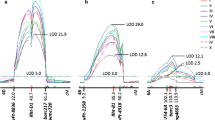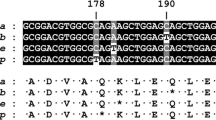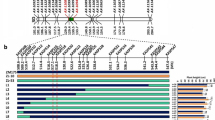Abstract
Key message
We identified a new wheat dwarfing allele Rht12b conferring reduced height and higher grain yield, pinpointed its causal variations, developed a breeding-applicable marker, and traced its origin and worldwide distribution.
Abstract
Plant height control is essential to optimize lodging resistance and yield gain in crops. RHT12 is a reduced height (Rht) locus that is identified in a mutationally induced dwarfing mutant and encodes a gibberellin 2-oxidase TaGA2oxA13. However, the artificial dwarfing allele is not used in wheat breeding due to excessive height reduction. Here, we confirmed a stable Rht locus, overlapping with RHT12, in a panel of wheat cultivars and its dwarfing allele reduced plant height by 5.4–8.2 cm, equivalent to Rht12b, a new allele of RHT12. We validated the effect of Rht12b on plant height in a bi-parent mapping population. Importantly, wheat cultivars carrying Rht12b had higher grain yield than those with the contrasting Rht12a allele. Rht12b conferred higher expression level of TaGA2oxA13. Transient activation assays defined SNP−390(C/A) in the promoter of TaGA2oxA13 as the causal variation. An efficient kompetitive allele-specific PCR marker was developed to diagnose Rht12b. Conjoint analysis showed that Rht12b plus the widely used Rht-D1b, Rht8 and Rht24b was the predominant Rht combination and conferred a moderate plant height in tested wheat cultivars. Evolutionary tracking uncovered that RHT12 locus arose from a tandem duplication event with Rht12b firstly appearing in wild emmer. The frequency of Rht12b was approximately 70% (700/1005) in a worldwide wheat panel and comparable to or higher than those of other widely used Rht genes, suggesting it had been subjected to positive selection. These findings not only identify a valuable Rht gene for wheat improvement but also develop a functionally diagnostic tool for marker-assisted breeding.



Similar content being viewed by others
Data availability
The datasets generated during the current study are available from the corresponding author on reasonable request.
References
Amalova A, Abugalieva S, Chudinov V, Sereda G, Tokhetova L, Abdikhalyk A et al (2021) QTL mapping of agronomic traits in wheat using the UK Avalon × Cadenza reference mapping population grown in Kazakhstan. PeerJ 9:e10733
Bazhenov MS, Divashuk MG, Amagai Y, Watanabe N, Karlov GI (2015) Isolation of the dwarfing Rht-B1p (Rht17) gene from wheat and the development of an allele-specific PCR marker. Mol Breeding 35:1–8
Borrill P, Mago R, Xu T, Ford B, Williams SJ, Derkx A et al (2022) An autoactive NB-LRR gene causes Rht13 dwarfism in wheat. Proc Natl Acad Sci USA 119:e2085092177
Buss W, Ford BA, Foo E, Schnippenkoetter W, Borrill P, Brooks B et al (2020) Overgrowth mutants determine the causal role of gibberellin GA2oxidaseA13 in Rht12 dwarfism of wheat. J Exp Bot 71:7171–7178
Chai L, Chen Z, Bian R, Zhai H, Cheng X, Peng H et al (2019) Dissection of two quantitative trait loci with pleiotropic effects on plant height and spike length linked in coupling phase on the short arm of chromosome 2D of common wheat (Triticum aestivum L.). Theor Appl Genet 132:1815–1831
Chai L, Xin M, Dong C, Chen Z, Zhai H, Zhuang J et al (2022) A natural variation in ribonuclease H-like gene underlies Rht8 to confer “Green Revolution” trait in wheat. Mol Plant 15:377–380
Chen L, Phillips AL, Condon AG, Parry MA, Hu YG (2013) GA-responsive dwarfing gene Rht12 affects the developmental and agronomic traits in common bread wheat. PLoS ONE 8:e62285
Chen Y, Song W, Xie X, Wang Z, Guan P, Peng H et al (2020) A collinearity-incorporating homology inference strategy for connecting emerging assemblies in the Triticeae tribe as a pilot practice in the plant pangenomic era. Mol Plant 13:1694–1708
Cheng H, Liu J, Wen J, Nie X, Xu L, Chen N et al (2019) Frequent intra- and inter-species introgression shapes the landscape of genetic variation in bread wheat. Genome Biol 20:136–152
Chow CN, Lee TY, Hung YC, Li GZ, Tseng KC, Liu YH et al (2019) PlantPAN3.0: a new and updated resource for reconstructing transcriptional regulatory networks from ChIP-seq experiments in plants. Nucleic Acids Res 47:D1155–D1163
Cui C, Lu Q, Zhao Z, Lu S, Duan S, Yang Y et al (2022) The fine mapping of dwarf gene Rht5 in bread wheat and its effects on plant height and main agronomic traits. Planta 255:114–133
Dubois M, Skirycz A, Claeys H, Maleux K, Dhondt S, De Bodt S et al (2013) Ethylene response factor6 acts as a central regulator of leaf growth under water-limiting conditions in Arabidopsis. Plant Physiol 162:319–332
Dvorák J, Terlizzi P, Zhang HB, Resta P (1993) The evolution of polyploid wheats: identification of the A genome donor species. Genome 36(1):21–31. https://doi.org/10.1139/g93-004
Ellis MH, Rebetzke GJ, Azanza F, Richards RA, Spielmeyer W (2005) Molecular mapping of gibberellin-responsive dwarfing genes in bread wheat. Theor Appl Genet 111:423–430
Ford BA, Foo E, Sharwood R, Karafiatova M, Vrána J, MacMillan C et al (2018) Rht18 semidwarfism in wheat is due to increased GA2-oxidaseA9 expression and reduced GA content. Plant Physiol 177:168–180
Hao C, Jiao C, Hou J, Li T, Liu H, Wang Y et al (2020) Resequencing of 145 landmark cultivars reveals asymmetric sub-genome selection and strong founder genotype effects on wheat breeding in China. Mol Plant 13:1733–1751
IWGSC (International Wheat Genome Sequencing Consortium) (2018) Shifting the limits in wheat research and breeding using a fully annotated reference genome. Science 361:7191
Korzun V, Roder M, Worland AJ, Brner A (1997) Intrachromosomal mapping of genes for dwarfing (Rht12) and vernalization response (Vrn1) in wheat by using RFLP and microsatellite markers. Plant Breed 116:227–232
Kumar S, Stecher G, Tamura K (2016) MEGA7: Molecular evolutionary genetics analysis version 7.0 for bigger datasets. Mol Biol Evol 33:1870–1874
Li C, Bai G, Carver BF, Chao S, Wang Z (2016) Mapping quantitative trait loci for plant adaptation and morphology traits in wheat using single nucleotide polymorphisms. Euphytica 208:299–312
Li F, Wen W, He Z, Liu J, Jin H, Cao S et al (2018) Genome-wide linkage mapping of yield-related traits in three Chinese bread wheat populations using high-density SNP markers. Theor Appl Genet 131:1903–1924
Li F, Wen W, Liu J, Zhang Y, Cao S, He Z et al (2019) Genetic architecture of grain yield in bread wheat based on genome-wide association studies. BMC Plant Biol 19:168
Licausi F, Ohme-Takagi M, Perata P (2013) APETALA2/ethylene responsive factor (AP2/ERF) transcription factors: mediators of stress responses and developmental programs. New Phytol 199:639–649
Ling HQ, Ma B, Shi X, Liu H, Dong L, Sun H et al (2018) Genome sequence of the progenitor of wheat A subgenome Triticum urartu. Nature 557:424–428
Liu J, He Z, Wu L, Bai B, Wen W, Xie C et al (2016) Genome-wide linkage mapping of QTL for black point reaction in bread wheat (Triticum aestivum L.). Theor Appl Genet 129:2179–2190
Liu J, Feng B, Xu Z, Fan X, Jiang F, Jin X et al (2018) A genome-wide association study of wheat yield and quality-related traits in southwest China. Mol Breed 38:1–11
Livak KJ, Schmittgen TD (2001) Analysis of relative gene expression data using real-time quantitative PCR and the 2(-Delta Delta C(T)) Method. Methods 25:402–408
Lu Y, Xing L, Xing S, Hu P, Cui C, Zhang M et al (2015) Characterization of a putative new semi-dominant reduced height gene, Rht_NM9, in wheat (Triticum aestivum L.). J Genet Genomics 42:685–698
Marcussen T, Sandve SR, Heier L, Spannagl M, Pfeifer M, Jakobsen KS et al (2014) Ancient hybridizations among the ancestral genomes of bread wheat. Science 345:1250092
Meng L, Li H, Zhang L, Wang J (2015) QTL IciMapping: integrated software for genetic linkage map construction and quantitative trait locus mapping in biparental populations. Crop J 3:269–283
Peng J, Richards DE, Hartley NM, Murphy GP, Devos KM, Flintham JE et al (1999) “Green revolution” genes encode mutant gibberellin response modulators. Nature 400:256–261
Pont C, Leroy T, Seidel M, Tondelli A, Duchemin W, Armisen D et al (2019) Tracing the ancestry of modern bread wheat. Nat Genet 51:905–911
Song J, Li L, Liu B, Dong Y, Dong Y, Li F et al (2023) Fine mapping of reduced height locus RHT26 in common wheat. Theor Appl Genet 136:62
Sun L, Yang W, Li Y, Shan Q, Ye X, Wang D et al (2019) A wheat dominant dwarfing line with Rht12, which reduces stem cell length and affects gibberellic acid synthesis, is a 5AL terminal deletion line. Plant J 97:887–900
Teng F, Zhai L, Liu R, Bai W, Wang L, Huo D et al (2013) ZmGA3ox2, a candidate gene for a major QTL, qPH3.1, for plant height in maize. Plant J 73:405–416
Tian X, Zhu Z, Xie L, Xu D, Li J, Fu C et al (2019) Preliminary exploration of the source, spread, and distribution of Rht24 reducing height in bread wheat. Crop Sci 59:19–24
Tian F, Yang DC, Meng YQ, Jin J, Gao G (2020) PlantRegMap: charting functional regulatory maps in plants. Nucleic Acids Res 48:D1104–D1113
Tian X, Xia X, Xu D, Liu Y, Xie L, Hassan MA et al (2022) Rht24b, an ancient variation of TaGA2ox-A9, reduces plant height without yield penalty in wheat. New Phytol 233:738–750
Van De Velde K, Thomas SG, Heyse F, Kaspar R, Van Der Straeten D, Rohde A (2021) N-terminal truncated RHT-1 proteins generated by translational reinitiation cause semi-dwarfing of wheat green revolution alleles. Mol Plant 14:679–687
Voorrips RE (2002) MapChart: software for the graphical presentation of linkage maps and QTLs. J Hered 93:77–78
Wang H, Yin H, Jiao C, Fang X, Wang G, Li G et al (2020) Sympatric speciation of wild emmer wheat driven by ecology and chromosomal rearrangements. Proc Natl Acad Sci USA 117:5955–5963
Wang Z, Wang W, Xie X, Wang Y, Yang Z, Peng H et al (2022) Dispersed emergence and protracted domestication of polyploid wheat uncovered by mosaic ancestral haploblock inference. Nat Commun 13:3891
Wang S, Basten C, Zeng Z (2012) Windows QTL cartographer v2.5. Department of Statistics, North Carolina State University, Raleigh, NC. http://statgen.ncsu.edu/qtlcart/WQTLCart.htm
Wu J, Kong X, Wan J, Liu X, Zhang X, Guo X et al (2011) Dominant and pleiotropic effects of a GAI gene in wheat results from a lack of interaction between DELLA and GID1. Plant Physiol 157:2120–2130
Xiong H, Zhou C, Fu M, Guo H, Xie Y, Zhao L et al (2022) Cloning and functional characterization of Rht8, a “Green Revolution” replacement gene in wheat. Mol Plant 15:373–376
Zanke CD, Ling J, Plieske J, Kollers S, Ebmeyer E, Korzun V et al (2014) Whole genome association mapping of plant height in winter wheat (Triticum aestivum L.). PLoS ONE 9:e113287
Zeng Z (1994) Precision mapping of quantitative trait loci. Genetics 136:1457–1468
Zhang M, Wei H, Hao P, Wu A, Ma Q, Zhang J et al (2021) GhGPAT12/25 are essential for the formation of anther cuticle and pollen exine in cotton (Gossypium hirsutum L.). Front Plant Sci 12:667739
Zhang H, Qi H, Sun Y, Feng X, Yang C, Zhuo W et al (2023a) Character diversity analysis of new wheat varieties from different origins in Huang-Huai winter wheat region. J Plant Genet Resour 24:719–731
Zhang J, Li C, Zhang W, Zhang X, Mo Y, Tranquilli GE et al (2023b) Wheat plant height locus RHT25 encodes a PLATZ transcription factor that interacts with DELLA (RHT1). Proc Natl Acad Sci USA 120:e1994764176
Zhou X, Stephens M (2012) Genome-wide efficient mixed-model analysis for association studies. Nat Genet 44:821–824
Zhou X, Zhang ZL, Park J, Tyler L, Yusuke J, Qiu K et al (2016) The ERF11 transcription factor promotes internode elongation by activating gibberellin biosynthesis and signaling. Plant Physiol 171:2760–2770
Zhou Y, Zhao X, Li Y, Xu J, Bi A, Kang L et al (2020) Triticum population sequencing provides insights into wheat adaptation. Nat Genet 52:1412–1422
Zhu L, Jiang B, Zhu J, Xiao G (2022) Auxin promotes fiber elongation by enhancing gibberellic acid biosynthesis in cotton. Plant Biotechnol J 20:423–425
Acknowledgements
We are grateful to Prof. Robert McIntosh, Plant Breeding Institute, University of Sydney, for revising this manuscript.
Funding
This work was supported by the National Key Research and Development Program of China (2022YFF1002904, 2022YFD1201500) and the Science and Technology Innovation Program of Chinese Academy of Agricultural Sciences (CAAS).
Author information
Authors and Affiliations
Contributions
YJB, LLL, XLT, DAX, MJS, FJL, LNX, SYL and BYL performed the experiments and participated in field trials; SHC and YJB wrote the draft manuscript; SHC and ZHH designed the experiments. XCX assisted in writing the manuscript.
Corresponding authors
Ethics declarations
Conflict of interest
We declare no conflicts of interest in regard to this manuscript.
Ethical approval
These experiments complied with the ethical standards in China.
Additional information
Communicated by Susanne Dreisigacker.
Publisher's Note
Springer Nature remains neutral with regard to jurisdictional claims in published maps and institutional affiliations.
Supplementary Information
Below is the link to the electronic supplementary material.
Rights and permissions
Springer Nature or its licensor (e.g. a society or other partner) holds exclusive rights to this article under a publishing agreement with the author(s) or other rightsholder(s); author self-archiving of the accepted manuscript version of this article is solely governed by the terms of such publishing agreement and applicable law.
About this article
Cite this article
Bian, Y., Li, L., Tian, X. et al. Rht12b, a widely used ancient allele of TaGA2oxA13, reduces plant height and enhances yield potential in wheat. Theor Appl Genet 136, 253 (2023). https://doi.org/10.1007/s00122-023-04502-y
Received:
Accepted:
Published:
DOI: https://doi.org/10.1007/s00122-023-04502-y




